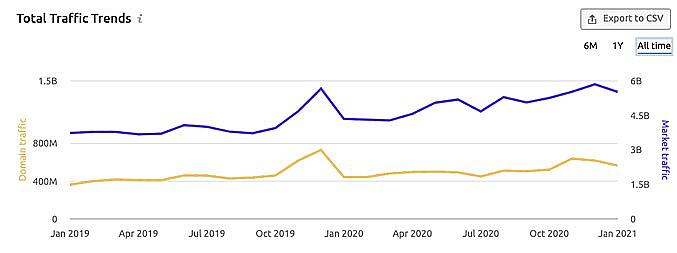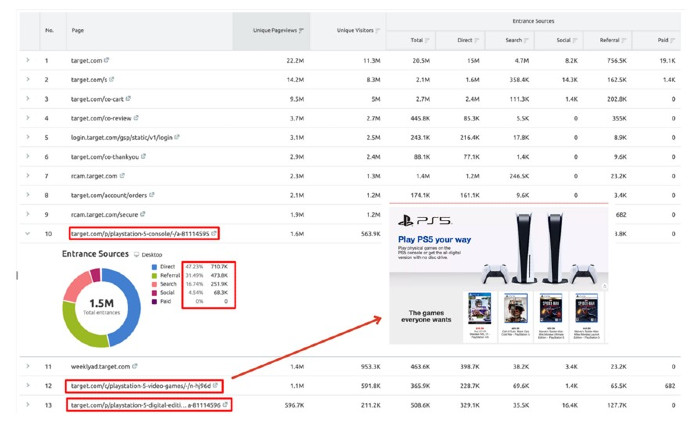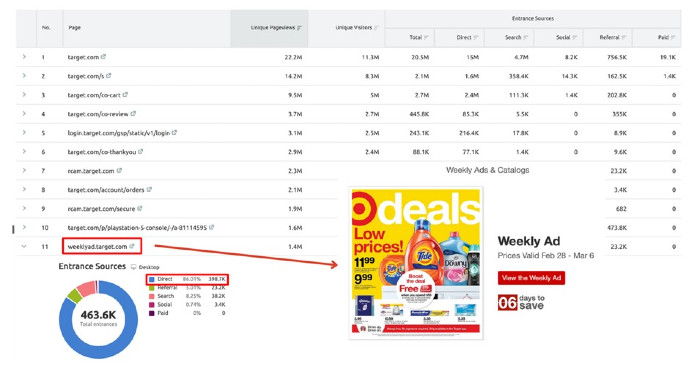The global pandemic challenged many businesses and pushed digitization to a brand-new level. And though most industries offline were in catastrophic decline, online was all about growth.
The US (and global) search traffic to top sites is surging, so in the digital space—especially today, when most indicators are up—if you aren't growing, you're losing market share and therefore customers.
This article will explain how you can use the power of competitive insights to pinpoint new growth points for your business.
Understanding the 'Business' Value of Competitive Analysis
In a growth-minded setting, competitor analysis can be a goldmine for uncovering new high-impact ideas that you can implement within your marketing and even business/product strategy. Instead of costly guesswork and high-risk experiments, you can rely on competitive intel to...
- Understand and factor in potential market and competitive threats
- Pinpoint gaps in similar product offerings
- Reveal the audience's real wants and needs (after all, you fight to win over the same audience)
- Spot seasonal trends and demand shifts, and adjust your product/marketing/business strategy accordingly
- Discover marketing channels to use and disregard those that don't work for your rivals
All you need to uncover those insights is a tried and tested framework and reliable tools.
How to Use Competitive Analysis to Discover New Growth Points
With the help of Semrush's competitive intel, we will show you how to easily employ a three-step framework that can trigger an inflow of ideas for business growth.
1. Identify general market dynamics and your market share
Before you start your exploration, you have to understand your own market position and trends specific to your industry.
We'll take Walmart as an example to see which opportunities the US e-tailer might be missing out on.
By simply entering Walmart's site into Market Explorer, we get an instant overview of the e-tail market landscape within the US:

In January 2021, Walmart got a whopping 10% of the US online retail market. But that number alone doesn't reveal much without looking into the general market patterns for previous periods.
So, let's check Walmart's growth/decline dynamics against the overall market trend:

Now we can see that the big-box retailer's traffic ups and downs are almost identical to the overall market's. This implies the brand's market share remained pretty stable (with a slight decline in July 2020) throughout the past year.
That's good news. However, stability may also imply stagnation because Walmart's traffic surge is consistent with overall market growth. To get ahead of the trend, Walmart might want to look into its key competitors to uncover new growth opportunities.
2. Reveal competitors' key traffic acquisition channels for smarter budgeting decisions
For starters, let's look at the Top 5 market players Walmart is competing against:

The traditional big-box retailers like Target and Costco are way behind Walmart. And since it has turned into a giant e-commerce destination rather than simply an e-tailer, Walmart is now competing against the likes of Amazon and eBay.
Market Explorer's Benchmarking report gives us a full view of the traffic generation strategy within our market and specific rivals:
Considering the dominance of direct traffic (over 55%), it's pretty clear that having strong brand awareness is the key to audience acquisition within this niche.
Walmart's key rivals, Amazon and eBay, have a larger share of direct visits and a much lower share of paid traffic. That implies Walmart should consider investing more in organic growth strategies rather than relying on paid channels. Curiously, Costco, the fifth most popular e-tailer, seems to have nailed the organic game with zero investment in paid search.
When we look at the social media breakdown, it becomes clear that Walmart is overly reliant on Facebook and the rest of the competition has a more equally distributed social media strategy, with a bigger emphasis on YouTube and some level of penetration of Reddit (absent in Walmart's case).
Just from this brief overview, we can already get some ideas for Walmart's future marketing strategy adjustments: shift advertising budgets to organic growth strategies and diversify social media strategy.
3. Get insights on competitors' top products or marketing campaigns
Now that we know how Walmart could enhance its overall marketing game, we should get a better understanding of what it should promote.
For products, Walmart still competes more with other big-box retailers. So we're using the Traffic Analytics tool to explore Target as the key rival here and to uncover its top offerings.
Revealing a rival's top products
With insights into Target's most visited pages, we can draw conclusions about its most popular products:
Sony PlayStation 5 absolutely dominates the top pages breakdown—from the console itself to the most-wanted PS5 videogames.

Walmart also promotes the video console, but when we compare both brands' traffic breakdown it becomes obvious that Walmart should be getting way more traffic coming from search (it gets just 2% compared with Target's 17%).
So, even if Walmart is targeting similar products to the top offer, it could learn a thing or two from its rivals about the best way to promote them.
Take note of trending marketing campaigns
You have to carefully explore your rivals' top pages because they not only showcase the most popular products but also possibly point to campaigns that are getting big audience traction.
In Target's top pages overview, we spotted a marketing campaign that attracts around 2% of its entire site visitor base. It's a separate page that features all the weekly special deals at any Target location: You can simply browse the offers and easily spot all the deals at a specific store.
Now, that approach is something Walmart could certainly make note of: to first keep an eye on its rival's promotions, and also to launch a similar campaign to attract Target's audience and increase the loyalty of its existing customers.
Triggering Your Business Growth
Although Walmart has the resources to employ large teams focused on this kind of market and marketing research, even they manage to miss out on some growth opportunities.
But sometimes you don't need a large team for uncovering marketing opportunities and ensuring business growth. All you need is the right framework and a tool like Traffic Analytics to deliver market and competitive insights that instantly reveal the key gaps between your marketing strategy and your competitors'.







